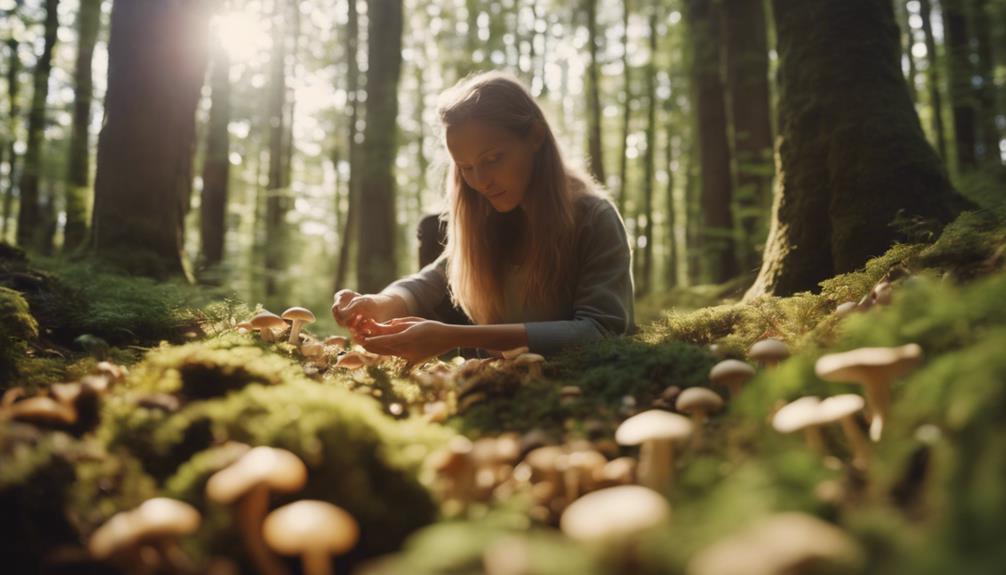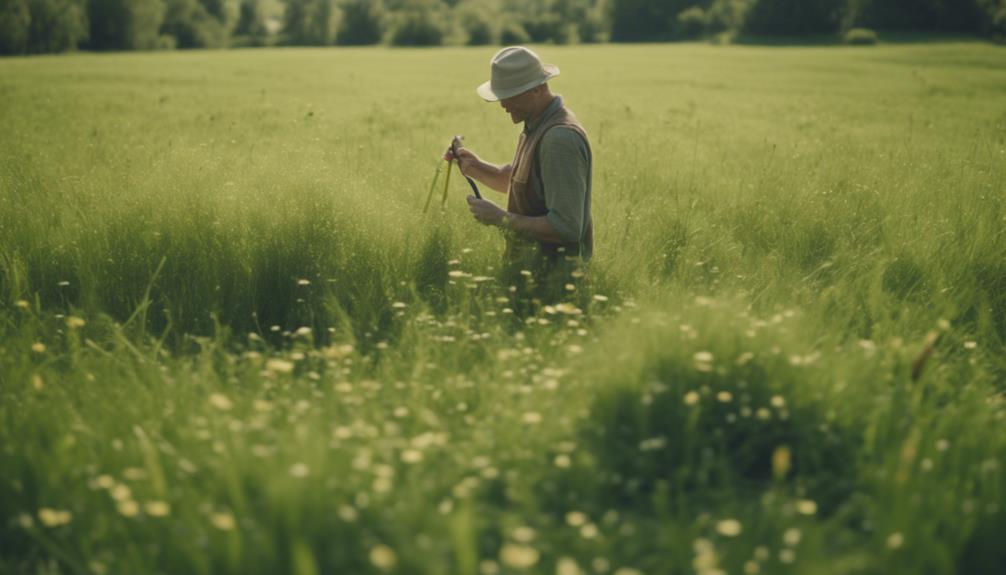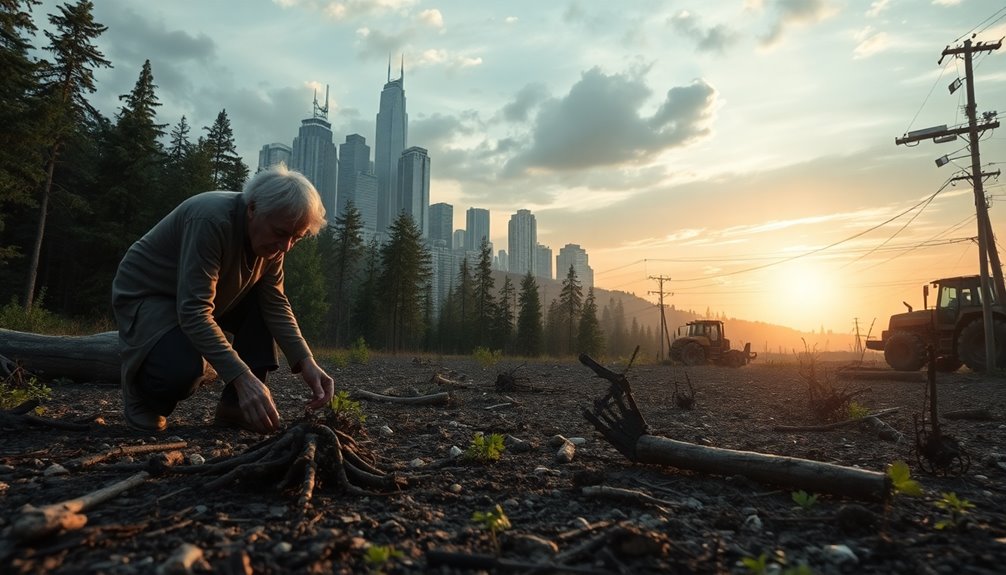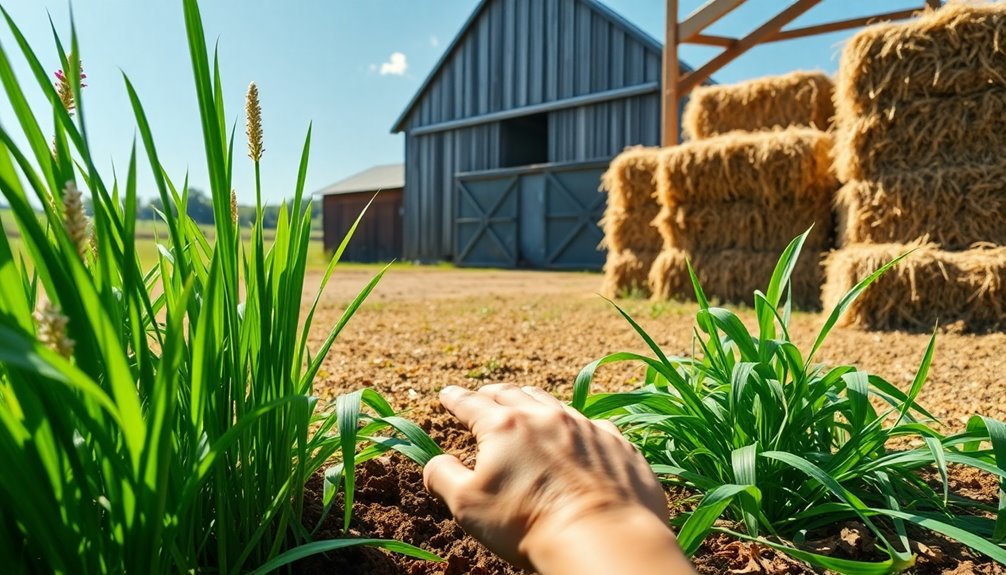Embark on an exciting journey into foraging, where nature reveals its edible treasures and enhances your culinary skills. Discover unique flavors, promote sustainable living, and gain a deeper appreciation for the natural world. Ensure safety by accurately identifying plants, avoiding polluted areas, and using essential tools like a field guide. Start with easy-to-identify plants such as dandelions and purslane, while respecting nature and local regulations. Harvest responsibly with ethical guidelines, promoting conservation and ecosystem health. Explore delicious foraged recipes like salads and smoothies brimming with fresh flavors and nutrients. Connect with foraging communities to share experiences and expand your knowledge. Delve into a realm of possibilities within the exciting world of foraging.
Key Takeaways
- Explore nature's edible treasures through foraging.
- Learn to identify common edible plants safely.
- Practice sustainable harvesting techniques.
- Try delicious foraged recipes for a culinary adventure.
- Join foraging communities for support and knowledge sharing.
Benefits of Foraging
Foraging offers you a gateway to explore the bountiful benefits of connecting with nature's edible treasures, particularly wild edible plants. Delving into the world of foraging not only provides access to free, nutritious, and delectable treasures but also fosters a deep connection with the environment. By learning to identify, harvest, and prepare wild edibles, you can enhance your culinary skills with untamed flavors that are unique to these plants. Engaging in foraging promotes sustainable living practices and enhances appreciation for the beauty and abundance of the natural world.
Seasonal foraging tips further enrich your foraging experience by helping you make the most of each time of year. This guarantees that you can enjoy a variety of wild edibles throughout the seasons, maximizing your exposure to different flavors and nutritional benefits.
Safety Guidelines for Beginners

To guarantee your safety as a beginner in foraging, it is essential to properly identify plants before consumption to avoid any potential health risks from toxic varieties. When foraging for wild plants, beginners should steer clear of areas that may be contaminated with pesticides or other pollutants. Always carry a trustworthy field guide or utilize a foraging app to assist in accurate plant identification and reduce the risk of ingesting harmful species. Start your foraging journey with easy-to-identify plants like dandelions, berries, or wild garlic before progressing to more complex options. Seeking guidance from experienced foragers or attending workshops can provide valuable insights into safe foraging practices and help you enhance your plant identification skills.
| Safety Guidelines for Foraging Beginners |
|---|
| 1. Properly identify wild plants before consumption to avoid toxic varieties |
| 2. Avoid foraging in polluted areas or where pesticides may be present |
| 3. Carry a field guide or use a foraging app for accurate plant identification |
| 4. Start with easy-to-identify plants like dandelions, berries, or wild garlic |
Essential Foraging Tools

When preparing for a foraging adventure, there are several essential tools you should have on hand.
A foraging basket or bag, field guide, and gardening gloves are key components to take into account.
These tools won't only help you collect wild edibles safely but also aid in plant identification and protection.
Must-Have Foraging Gear
Equipped with essential foraging gear, you'll be ready to begin your wild edibles hunting adventures with confidence and preparedness. A sturdy backpack is crucial to carry your foraging tools, including a field guide for plant identification, a pocket knife for harvesting, gloves for protection, and containers for collecting plants.
Tools like a magnifying glass aid in plant identification, while a compass or GPS device helps navigate foraging locations efficiently.
Don't forget to pack a water bottle, snacks, and a first aid kit for safety and hydration during your expeditions. Using a foraging basket or bag with compartments will help protect delicate wild edibles.
Make sure your gear is lightweight, durable, and suitable for outdoor conditions to enhance your foraging experience and promote sustainability. With the right equipment, you'll be well-prepared to explore the thrilling world of foraging and discover the wonders of edible plants in nature.
Safety Precautions to Consider
Safeguard your safety during foraging expeditions by equipping yourself with essential tools for plant harvesting and protection. When venturing into the wilderness, safety precautions are crucial. Wear appropriate clothing and sturdy footwear to navigate rough terrain comfortably.
Bring a first aid kit for emergencies and inform someone of your foraging location and expected return time for added security. Be vigilant of potential hazards such as poisonous plants, sharp objects, and wildlife encounters. To mitigate risks, properly identify edible plants using field guides, apps, or consulting experienced foragers to avoid toxic species.
Start with easy-to-identify plants, practice sustainable foraging techniques, and respect nature by taking only what's necessary. Remember, foraging can be a rewarding experience, but prioritizing safety ensures a successful and enjoyable outing in the bountiful world of wild edibles.
Identifying Common Edible Plants
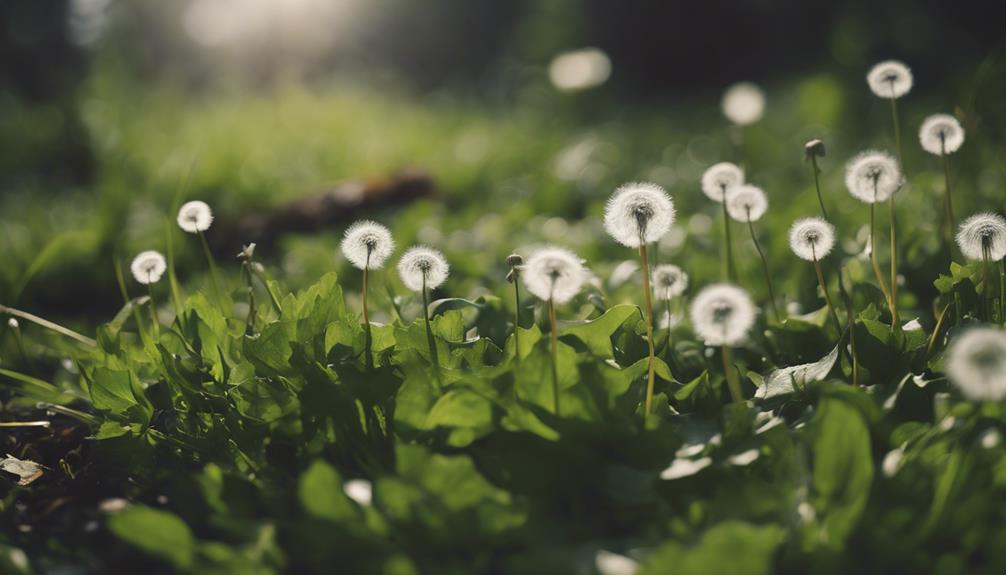
To successfully identify common edible plants, focus on studying their key characteristics such as leaves, stems, flowers, and growth patterns. Many common edible plants, including dandelions, plantains, chickweed, and purslane, offer both nutritional benefits and medicinal properties.
Pay attention to the shape and color of the leaves, the arrangement of the stems, and the appearance of the flowers. Dandelion leaves, for example, are jagged and bright green, while chickweed has small, oval-shaped leaves. Plantains typically have long, ribbed leaves that grow in a basal rosette pattern. Identifying these features correctly is essential to avoid consuming toxic varieties that may resemble edible plants.
Utilize field guides, apps, or seek advice from foraging experts to enhance your knowledge and ensure accurate identification. Remember, proper identification is important for a safe and enjoyable foraging experience.
Harvesting Techniques for Beginners

To develop your foraging skills further, familiarize yourself with effective harvesting techniques for beginners. Mastering the art of foraging involves more than just identifying plants; it also encompasses how you harvest them.
Here are some essential harvesting techniques to enhance your foraging experience:
- Proper Identification: Always correctly identify the plants you intend to harvest to avoid consuming toxic or harmful species. Utilize field guides, apps, and expert advice to make sure you gather safe edibles.
- Safe Harvesting Practices: Practice ethical foraging by only taking what you need, leaving enough for wildlife and other foragers. Use proper tools like scissors or knives to minimize damage to plants and their ecosystems.
- Sustainable Foraging Methods: Respect nature by following local regulations, foraging in moderation, and not disturbing delicate habitats. Harvest in a way that allows plants to regrow and thrive for future foraging endeavors.
Delicious Foraging Recipes to Try

Ready to elevate your culinary skills with foraged ingredients?
Try whipping up a Tasty Foraged Salad bursting with fresh flavors.
Or blend up an invigorating Wild Berry Smoothie for a nutritious treat.
These recipes showcase the best of what nature has to offer, allowing you to enjoy the delicious rewards of your foraging adventures.
Tasty Foraged Salad
Explore the world of delicious foraging recipes by starting with a flavorful and nutritious foraged salad. Wild edibles like dandelion greens, chickweed, purslane, and violets can transform a simple salad into a culinary adventure.
Incorporating these unique ingredients not only adds a burst of flavor but also boosts the nutritional value of your dish with essential vitamins, minerals, and antioxidants.
Here's how to create a tasty foraged salad:
- Gather Your Greens: Head out into the wild and collect a variety of wild plants such as dandelion greens, chickweed, and purslane.
- Add Some Flair: Enhance the flavor profile of your salad by including edible flowers like violets or other wild edibles such as lambsquarters, plantain, and wood sorrel.
- Enjoy the Bounty: Toss your foraged ingredients together with a simple dressing and indulge in a fresh and sustainable meal that connects you to nature while offering a unique culinary experience.
Wild Berry Smoothie
Consider incorporating foraged wild berries into your diet for a delightful and nutritious treat. Wild berry smoothies are not only delicious but also packed with essential nutrients such as antioxidants, vitamins, and minerals. Foraging for edible wild berries is a fun and rewarding outdoor activity that can enhance the nutritional value of your smoothie while promoting sustainability and a deeper connection with nature.
To highlight the benefits of incorporating wild berries into your diet, let's take a look at the nutritional content of some common types of wild berries:
| Wild Berry | Nutrients | Health Benefits |
|---|---|---|
| Strawberries | Vitamin C, Fiber | Boosts Immunity |
| Blueberries | Antioxidants, Vitamin K | Supports Brain Health |
| Blackberries | Vitamin A, Vitamin C | Improves Skin Health |
| Raspberries | Fiber, Manganese | Aids Digestion |
| Elderberries | Vitamin A, Potassium | Anti-inflammatory Effects |
Incorporating these wild berries into your smoothie can provide a flavorful and healthful boost to your day.
Sustainable Foraging Practices

To practice sustainable foraging, it's crucial to harvest wild plants and fungi in a manner that prioritizes the long-term health of the ecosystem. This involves gathering wild edibles responsibly, without causing harm to the environment or depleting natural resources. Sustainable foraging includes following ethical guidelines, such as not over-harvesting, respecting wildlife habitats, and preserving biodiversity.
Here are three key points to ponder when engaging in sustainable foraging:
- Responsible Harvesting: Only collect what you need, leaving enough behind for wildlife and future growth.
- Environmental Awareness: Learn about the local ecosystem, plant life cycles, and conservation efforts to make informed foraging decisions.
- Promote Conservation: Support sustainability by advocating for the protection of natural areas, participating in clean-up efforts, and spreading awareness about responsible foraging practices.
Joining Foraging Communities
To expand your foraging knowledge and connect with others who share your passion, consider joining foraging communities where you can engage in discussions and share experiences. By becoming part of these communities, you gain access to a wealth of information, tips, and support from both beginners and seasoned foragers. Here's what you need to know:
| Benefits of Joining Foraging Communities | How to Get Involved |
|---|---|
| Connect with like-minded individuals | Create an account |
| Share experiences and tips | Follow friends |
| Ask questions and seek advice | Participate in conversations |
| Share quotes, thoughts, and book recommendations | Engage in discussions |
| Supportive environment for all levels of foragers | Share experiences and knowledge |
Joining these communities not only enhances your foraging skills but also provides a sense of belonging and camaraderie within a community of individuals who share your passion.
Frequently Asked Questions
What Are the Best Books on Foraging?
Looking to learn about foraging? Explore 'Foraging Made Easy: The Complete Beginners Guide.' It offers essential tips on finding, identifying, and cooking wild edibles. Readers appreciate its detailed info and recipes. Check it out!
How to Get Started With Foraging?
To get started with foraging, begin by learning to recognize common edible plants, following safety guidelines, and seeking expert advice. Use tools like guidebooks and apps, and remember to research local laws and practice sustainability.
Is Foraging Legal in Wisconsin?
Yes, foraging is legal in Wisconsin, but regulations vary. Remember, on public land, it's generally allowed for personal use. Be sure to check rules, get landowner permission on private property, and protect native species.
Can You Forage in Michigan State Parks?
Yes, you can forage in Michigan State Parks for personal use and non-commercial purposes. Follow park regulations and guidelines. Collect berries, nuts, and mushrooms in designated areas, but avoid protected zones. Always check park-specific rules.
Conclusion
To sum up, foraging isn't only a fun and rewarding activity but also a sustainable way to connect with nature and enjoy fresh, local produce.
Did you know that foraging can help reduce food waste and lower your carbon footprint?
By sourcing food directly from the land, you can play a part in promoting environmental conservation and supporting local ecosystems.
So grab your basket and start exploring the exciting world of foraging today!

